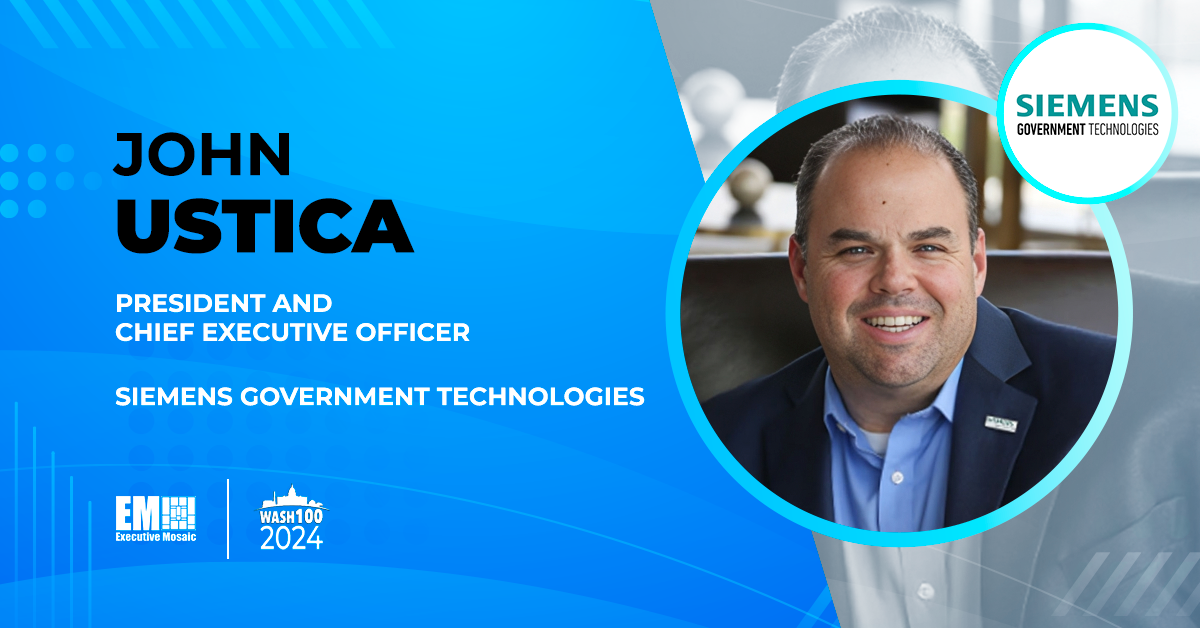Physical and cyber threats are evolving and escalating. Aging infrastructure must be modernized. And tightening regulations and new mandates are pressing government leaders to improve transparency, productivity and sustainability. As a result, there is a critical need for federal agencies to advance their digital transformation.
Siemens Government Technologies President and CEO John Ustica leads SGT with deep technological and business expertise during a time in which digital engineering, energy, microelectronics, digital twin technology and automation are more consequential to government missions than ever. With more than two decades of senior leadership experience at Siemens, Ustica has a deep understanding of the company and the needs of government customers to advance transformative initiatives that unlock new levels of efficiency, security and sustainability across military bases and depots.
Ustica, a two-time Wash100 Award winner, recently sat down with Executive Mosaic to discuss how SGT — the integrator of Siemens’ comprehensive portfolio of software and services for digital industries in the federal government — is helping customers deploy tools and technologies that connect the real and virtual worlds to optimize operations, modernize infrastructure and ensure mission-readiness on all fronts.
John, why is modernizing the organic industrial base a critical component of the government’s digital transformation strategy?
The organic industrial base, or OIB, refers to the network of government-owned and government-operated facilities, workforce and capabilities responsible for developing, deploying and maintaining military systems, equipment and services. Therefore, the OIB is essential to our nation’s security and readiness. It must be able to support peacetime requirements, while also being agile enough to respond during mobilizations and emergencies. However, the OIB is currently facing a number of challenges, including aging infrastructure and supply chain instability. Therefore, the Department of Defense must fully modernize the OIB, and this will require a comprehensive digital-first approach.
How can the DOD develop and deploy a comprehensive OIB digital transformation strategy?
Generally speaking, a comprehensive OIB digital transformation strategy will require investment in integrated, flexible and long-term digital solutions that can adapt to an unpredictable military and geopolitical future with speed, accuracy and innovation. But most importantly, this strategy will not be a “one-size-fits-all” approach. Rather, it must be based on a common, customizable platform that can access critical information, operate efficiently and enable seamless collaboration.
For example, through Siemens Xcelerator, SGT is helping the DOD meet its goals for an adaptive acquisition framework for agile development and sustainment of its vital systems. By leveraging a comprehensive and open digital portfolio to speed the development and delivery of innovative capabilities across DOD and its entire supply chain, we are helping to solve some of the most complex government challenges in infrastructure, automation and digitalization and connect the real and virtual worlds for our customers.
Can you talk about an example of how SGT is helping the DOD accelerate digital transformation?
We’ve been working closely with the National Center for Manufacturing Sciences and a leading team of industry partners to support the U.S. Navy’s modernization efforts associated with their Shipyard Infrastructure Optimization program. By developing the world’s largest known industrial digital twin to optimize their shipyard processes, reduce maintenance time and speed their delivery of vital fleet capabilities, the Navy is leveraging Siemens Xcelerator by combining the real and virtual worlds to acquire new insights and solutions for some of their most pressing ship maintenance challenges. The tremendous advantage for the Navy is that they’re able to simulate, visualize, analyze and test changes to their production systems and logistics processes in a closed virtual environment, without disrupting current work or missions. As a result, the Navy can optimize maintenance cycles, better monitor assets and lower repair costs.
How can other service branches embrace optimization opportunities across their networks?
Today there is great opportunity in leveraging artificial intelligence and cloud connected technologies. Cloud technologies — when implemented with robust security protocols — unlock new levels of efficiency and speed information flow for federal agencies to deliver on their missions from anywhere, at any time. By improving connection and communication between personnel, organizations and IoT devices, cloud technologies increase internal and external data accessibility for faster, data-driven decisions. For example, Siemens Defense Cloud is a Software-as-a-Service (SaaS) application suite available on the Federal Risk and Authorization Management Program (FedRAMP) Marketplace as ‘ready’ at the high impact level.
Capable of handling the government’s most sensitive, unclassified data, Siemens Defense Cloud can help federal agencies accelerate the adoption of new processes and technologies, scale workflows and leverage information more efficiently through the entire product lifecycle.



